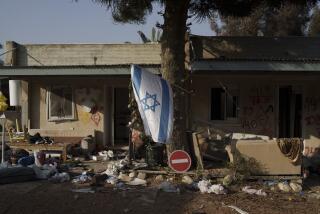Soviet Scholars Shed New Light on Cuban Missile Crisis
- Share via
WASHINGTON — Soviet scholars are shedding new light on the 1962 Cuban missile crisis, including the disclosure that Moscow had twice as many troops in Cuba as the Kennedy Administration believed, says an American author.
“Startling new information will require a revision of historical and analytic accounts of the events of the Cuban missile crisis,” Raymond L. Garthoff writes in the autumn edition of the journal Foreign Policy.
Garthoff, a senior fellow at the Brookings Institution and a State Department participant in the crisis, based his article on Soviet sources who under the policy of greater openness, or glasnost, are beginning to publicly discuss formerly taboo subjects.
42,000 Soviet Troops
Perhaps the most eye-opening revelation in Garthoff’s article is the presence in Cuba of 42,000 Soviet troops in the fall of 1962.
“While the United States had very good intelligence on the missiles in Cuba in October and November, 1962, its information on the number of Soviet military personnel was weak,” Garthoff wrote.
“Official U.S. intelligence estimates rose from 4,500 on Oct. 3, to some 8,000-10,000 by Oct. 22, to 12,000-16,000 by Nov. 19, and finally to 22,000 in a retroactive estimate in early 1963,” he said.
“But, it turns out, this figure was still far too low. Years later, Fidel Castro said the number was 40,000. Sergo Mikoyan (a Soviet scholar) has now confirmed that the full Soviet military complement in Cuba in October, 1962, totaled 42,000 men,” wrote Garthoff.
Other Disclosures
Among the other disclosures:
--Nikita S. Khrushchev, then the Kremlin leader, decided to secretly place nuclear-tipped SS-4 and SS-5 missiles in Cuba without a formal decision by the ruling Politburo. Such “voluntaristic” actions led to Khrushchev’s downfall two years later.
--Khrushchev considered running a naval blockade ordered by President Kennedy, but was dissuaded by Anastas A. Mikoyan, then deputy Soviet premier.
--Khrushchev did not authorize a proposal by the KGB station chief in Washington, Alexander Fomin, to U.S. journalist John Scali that was long thought to have been the key to ending the crisis. The deal, which was very close to the final resolution, called for withdrawal of Soviet missiles from Cuba in return for removal of U.S. missiles from Turkey.
--Soviet leaders hurriedly cut a diplomatic deal to get their missiles out of Cuba because they thought a U.S. invasion of the Caribbean island was imminent.
--The commander of Soviet forces in Cuba at the time was a four-star general, Issa Pliyev, an odd choice because Pliyev was a career cavalry officer unfamiliar with missiles and with only one previous foreign assignment, in the Far East before and during World War II.
--The decision to shoot down a U.S. U-2 spy plane over Cuba during the crisis was made by a Soviet one-star general on the scene, Igor Statsenko, and surprised Khrushchev, helping spur him to lower tension.
Two Intellectuals as Source
Most of the new disclosures come from two intellectuals associated with the reforms of Soviet leader Mikhail S. Gorbachev: Fyodor M. Burlatsky, who was a member of Khrushchev’s inner circle, and Sergo Mikoyan, who is the son of Anastas Mikoyan and is an expert on Soviet-Cuban relations. Mikoyan drew on his father’s unpublished memoirs.
Garthoff also quoted a number of unidentified Soviet officials who he said are well-placed but not ready to step into the spotlight.
More disclosures are possible at an international conference on the Cuban missile crisis tentatively scheduled for January, 1989 in Moscow.
Crisis Management
Despite the disclosures, little is known about Soviet decision-making in the crisis, prompting Garthoff to conclude that “crisis management, even when handled well, is a poor alternative to crisis prevention. . . . Glasnost, in policy as in politics and history, can help avert new superpower crises.”
And Garthoff said the Kremlin is placing more importance on accurate historical analysis, a rarity before Gorbachev came to power in March, 1985.
“For nearly two decades before 1985, the name Nikita Khrushchev . . . was absent from the brief, occasional and carefully circumscribed Soviet accounts of the crisis,” Garthoff wrote. “Some writers even managed to address the topic without mentioning the presence in, and removal from, Cuba of Soviet missiles.”
He said more recent Soviet articles have been more balanced, but added, “New light on Moscow’s key decisions in the crisis has scarcely begun to appear in the Soviet media--although it probably will within the year.”
More to Read
Sign up for Essential California
The most important California stories and recommendations in your inbox every morning.
You may occasionally receive promotional content from the Los Angeles Times.









